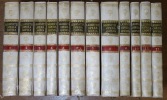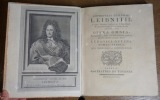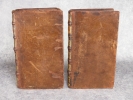-
Type
Book (250)
Magazine (1)
-
Century
17th (10)
18th (14)
19th (24)
20th (103)
21st (11)
-
Countries
Belgium (42)
Canada (1)
Denmark (18)
France (183)
Germany (1)
Italy (1)
Switzerland (5)
-
Syndicate
ALAC (1)
ILAB (110)
NVVA (2)
SLACES (2)
SLAM (89)
La Monadologie - Collection le livre de poche n°4606.
Le livre de poche / librairie générale française. 1991. In-12. Broché. Etat d'usage, Couv. convenable, Dos satisfaisant, Papier jauni. 317 pages.. . . . Classification Dewey : 100-PHILOSOPHIE ET DISCIPLINES CONNEXES
Collection le livre de poche n°4606 - Edition critique établie par Emile Boutroux précédée d'une étude de Jacques Rivelaygue, la monadologie de Leibniz suivie d'un exposé d'Emile Boutroux la philosophie de Leibniz. Classification Dewey : 100-PHILOSOPHIE ET DISCIPLINES CONNEXES
Leibniz. Discours de mtaphysique. ëditions collationne avec le texte autographe prsente et annote par Henri Lestienne
Gnrique Broch D'occasion bon tat 01/01/1929 150 pages
Leibniz. La Monadologie publiée d'après les manuscrits de la bibliothèque de Hanovre avec introduction notes et suppléments par Henri Lachelier
Hachette 1881 99 pages 1881. 99 pages.
LETTRES ET OPUSCULES INÉDITS DE LEIBNIZ, précédés d'une introduction de A. Foucher de Careil
Paris Librairie Philosophique de Ladrange 1854 in 8 (22x14,5) 1 volume reliure demi chagrin vert de l'époque, dos lisse orné de faux-nerfs à froid soulignés de filets dorés, CXII et 334 pages [1], rousseurs. Bon exemplaire, bien relié ( Photographies sur demande / We can send pictures of this book on simple request )
Très bon Couverture rigide
Nouveaux Essais sur l'entendement humain.
Flammarion, s.d. (1930), fort in-12, 532 pp, broché, papier jauni, bon état
Nouveaux essais sur l'entendement humain
Paris, GF-Flammarion 1990 441pp., 18cm., belle reliure demi-cuir (titre et faux-nerfs dorés au dos), bel état, F61311
Nouveaux essais sur l'entendement humáin
BROCHE. 1966. 500 PAGES. TEXTE INTEGRAL. PHOTOS SUR DEMANDE
Merci de nous contacter à l'avance si vous souhaitez consulter une référence dans notre boutique à Authon-du-Perche.
Nouvelles lettres et opuscules inédits. précédés d'une introduction par A. Foucher de Careil
Paris, Auguste Durand, 1857 in-8, VIII-CCXIX-440 pp., demi-veau blond, dos à nerfs orné de filets, pointillés et caissons dorés, pièce de titre noire, tête dorée (reliure de l'époque). Rousseurs, des pages piquées.
Louis-Alexandre Foucher de Careil (1825-1891) fut au XIXe siècle l'éditeur des Oeuvres de Leibniz, entreprises à partir d'un voyage documentaire en Allemagne et déclinées en deux séries : Lettres et opuscules (1854-1857, dont fait partie notre ouvrage) ; Oeuvres proprement dites (1859-1875, en sept volumes). Pour la France, cette publication éclipsa et remplaça celle de Dutens (1768, six volumes). - - VENTE PAR CORRESPONDANCE UNIQUEMENT - LIEN DE PAIEMENT, NOUS CONSULTER.
Observatio, quod rationes sive proportiones non habeant locum circa quantitates nihilo minores, et de vero sensu methodi infinitesimalis. - [LEIBNIZ ON INFINITESIMALS]
Leipzig, Grosse & Gleditsch, 1712. 4to. In: ""Acta Eruditorum Anno MDCCXII"". The entire volume offered in contemporary full vellum. Hand written title on spine. A yellow label pasted on to top of spine. A small stamp to title-page and free front end-paper. Library label to pasted down front free end-paper. As usual with various browning to leaves and plates. Pp. 167-69. [Entire volume: (2), 555, (35) pp. + five engraved plates.].
First printing of one of Leibniz's latest publications in which he proposed an interpretation of infinitesimals by a comparison of bodies of different extensions. The paper is a response to to a problem raised by French philosopher and mathematician Antoine Arnauld, who wrote an important philosophical work known as ""The Logic of Port-Royal"" from 1662 and ""Geometry"", 1667. In the book he includes an example of symbolic rules that he considers to be against our basic intuitions on magnitudes and proportions. His reasoning goes as follows ""Suppose we have two numbers, a larger and a smaller one. The proportion of the larger to the smaller one should evidently be larger than the proportion of the smaller to the larger one. But if we use 1 as the larger number and - 1 as the smaller one this would lead to (1/-1) > (-1/1) which is against the rules of algebra"". (Heeffer, The Methodological Relevance of the History of Mathematics for Mathematics Education, 1992).Leibniz saw this as a genuine mathematical problem but argued that the division should be performed as a symbolic calculation. ""Following Leibniz, the infinite appeared in two forms as the (i) Contiuous infinite and (ii) the discrete infinite. The status of the differentials is closely related to the status of the infinite. [...] As a consequence, there is no clear and consistence distinction between continua of different kind related to (i) geometry and to (ii) mechanics. [...] Leinbiz did neither consequently argue mathematically or arithmetically nor consequently geometrically, phenomenologically and mechanically. [But] The correlation between mathematics and physics is as impressive as possible. (Suisky, Euler as physicist, 2009, p. 89-90).The volume also contains:Bernoulli, Johann. Angulorum arcuumque sectio indefinita per formulam universalem expressa. Pp. 274-277" 329-30.And many other papers by influential contemporary mathematicians, philosophers and historians.
Opera omnia, nunc primum collecta, in Classes distributa, præfationibus & indicibus exornata, studio Ludovici Dutens
1768 Genève, Fratres de Tournes, 1768, 6 tomes en 12 vol. in 4 de 1f. blanc-IV-(2)-CCXLIV-296 pp. ; (2) blanc, (2)- p. 297 à p. 790 ; 1f. blanc-(2)-VIII-400 pp. ; 1 f. blanc-291 pp. ; 1 f. blanc-(2)-LV-272 pp. ; 1 f. blanc, (2)- p. 273 à p. 663 ; 1 f. blanc-VIII-285 pp. ; 1 f. blanc-VIII-352 pp. ; 1f. blanc-(2)-647 pp. ; 1 f. blanc-(2)-p. 353 à p. 632 ; 1f. blanc, VI-1 f. blanc-334 pp. ; 1 f. blanc-344 pp., rel. d'ép. demi-velin ivoire à coins, dos lisses ornés de fleurons et roulettes dorées, pièces de titres de maroquin vert et de tomaisons de maroquin rouge, plats recouverts de papier dominoté à motifs d'étoiles vieux rouge (orange), bel ex. non rogné.
Première édition collective, publiée par Louis Dutens, illustrée du portrait de l'auteur gravé en frontispice du 1er volume et de 42 planches gravées dépliantes. Il s'agit de la plus importante édition ancienne des œuvres de Leibniz, qui fait encore aujourd'hui référence. L'auteur, à la manière des grands esprits de la Renaissance y traite de toutes les sciences : mathématiques, physique, logique, métaphysique, chimie, sciences naturelles, histoire, droit, théologie, philologie, sinologie, etc. (Brunet, III, 950). Texte en latin et en français.
Opuscules Philosophiques Choisis
Paris Librairie Philosophique J. Vrin 1966 1 in-12 Broché 154 [pp]
Bon état général, couverture légèrement jaunie au niveau de la tranche Disponibilité sous réserve de vente en boutique, prix valable frais de port inclus pour commande > 90 € et poids < 1 Kg
REFUTATION INEDITE DE SPINOZA
BABEL. 1999. In-12. Broché. Bon état, Couv. convenable, Dos satisfaisant, Intérieur frais. 101 pages - trace d'étiquette sur le 2eme plat. . . . Classification Dewey : 190-Philosophie occidentale moderne
remarques critiques de Leibniz sur un livre de J.G. Wachter à propos de la philosophie cachée des hébreux d'après le manuscrit original de la bibliothèque royale de Hanovre - Lecture et appareil critique de Martine de Gaudemar Classification Dewey : 190-Philosophie occidentale moderne
SCRITTI FILOSOFICI. 1. Scritti di metafisica. Saggi di teodicea. 2. Nuovi saggi sull'intelletto umano e saggi preparatori. Scritti vari. Lettere
Unione Tipografico-editrice Torinese 1967 in8. 1967. Broché. 2 volume(s).
Bon état couverture défraîchie intérieur propre premier plat du tome 1 recollée
ESSAIS DE THEODICEE, SUR LA BONTE DE DIEU, LA LIBERTE DE L’HOMME ET L’ORIGINE DU MAL. PAR MR LEIBNITZ. SECONDE EDITION.
A AMSTERDAM. CHEZ ISAAC TROYEL, LIBRAIRE. 1714. 2 VOLUMES IN-12 (10 X 16,5 X 5,5 CENTIMETRES ENVIRON) DE (36) + 386 PAGES ET (2) + 216 + 132 PAGES, RELIURE D'EPOQUE PLEIN VEAU BRUN, DOS A 5 NERFS ORNE DE CAISSONS A FLEURONS DORES, TITRE DORE SUR ETIQUETTE MAROQUIN HAVANE, TRANCHES MOUCHETEES ROUGES. RARE SECONDE EDITION DONT ON CONNAIT PEU D’EXEMPLAIRES. PETIT MANQUE DE PAPIER SANS MANQUE DE TEXTE EN MARGE INFERIEURE BASSE DU PREMIER FEUILLET DE PREFACE DU TOME I, PETITE ROUSSEUR AYANT CAUSE UN PETIT TROU SANS GRAVITE PAGES 11/12 ET 161/162 DU TOME I, QUELQUES PETITS DEFAUTS EXTERIEURS, SINON BON EXEMPLAIRE.
Leibnitz. La Monadologie publie d'apr¿s les manuscrits et accompagne d'claircissements par ëmile Boutroux ... suivi d'une Note sur les principes de la mcanique dans Descartes et dans Leibnitz par Henri Poincar
C. Delagrave Broch D'occasion bon tat 01/01/1881 232 pages
LEIBNIZ (Gottfried Wilhelm, Freiherr von), EMERY (Jacques André) éditeur
Reference : 36777
Pensées de Leibniz sur la religion et la morale. Seconde Edition de l'Ouvrage intitulé 'Esprit de Leibniz', considérablement augmenté.
2 volumes in-8, demi-basane fauve de l'époque, dos lisses ornés de roulettes et de fleurons dorés, pièces de titre et de tomaison de maroquin rouge, tanches mouchetées, lxxvj, 310 p. et (2) f., 511 p. Paris, Vve Nyon, et la Librairie de la Société Typographique, An XI - 1803.
Seconde édition, la première sous ce titre, de cette synthèse de la doctrine leibnizienne augmentée d'un important "Discours préliminaire" (76 p.), de l'éloge de Leibniz par Fontenelle, de la controverse entre Leibniz et Bossuet sur la réunion des luthériens à l'Église romaine et d'une importante partie consacrée à la Morale chez Leibniz.Contient en fin, les "Principes de la philosophie de Leibniz", opuscule composé par Leibniz lui-même en 1714, résumé de sa doctrine en 93 petits chapitres, à destination du Prince Eugène de Savoie.(France littéraire, III, 19-20).Mors fendus, dos frottés avec manques en pied, rousseurs.


Phone number : 33 01 47 07 40 60
De la tolérance des religions, lettres de M. de Leibniz, et réponses de M. Pellisson
Paris Jean Anisson 1692 In-12° (159 x 99 mm), [4] ff. - 147 pp. - [1] f. - 185 pp., basane, dos à cinq nerfs orné, tranches mouchetées (reliure de l'époque)
Seconde édition, augmentée par rapport à l'originale de plusieurs lettres ainsi que de pièces historiques concernant la permission de donner le calice aux laïcs. Paul Pellisson engage en 1690 une correspondance avec Leibniz, débattant avec lui sur les questions de l'infaillibilité de l'église romaine, l'excommunication des protestants ou encore l'autorité ecclésiastique. Pellisson fait paraître leur échange épistolaire, en 1691, dans la quatrième partie de ses Réflexions sur les différends de la religion (Paris, chez la Veuve de Gabriel Martin, 1691, in-4°), l'amputant à son avantage de quelques unes des explications de Leibniz. La présente édition, parue un an après l'originale, ne rend pas plus justice à Leibniz. Ce-dernier écrivait en effet à Hugens : "Jay esté surpris que M. Pelisson a mis, surtout dans les additions, des choses que je laurois prié den retrancher, si javois scu son intention. Ce nest pas quil y ait du mal, mais cest quil y a quelque fois du mal-entendu dans le monde". Leibniz fut en outre chagriné de voir son nom apparaître au titre de cette seconde édition. Il confesse à Basnage : "Je nai pas encore vu lédition in-12° du traité de Mr. Pelisson de la tolerance des religions. Javois bien des raisons pour ne pas y vouloir paroitre en mon propre et privé nom. Mais je vois que cest une chose faite. Vous savez quun homme qui est ou je suis a bien des mesures a garder. Des personnes mal intentionnées pourront tourner mes paroles en mauvaise part, comme si je favorisais lindifférence." Il existe une contrefaçon hollandaise parue à la même date à la fausse adresse de Cologne chez Andre Pierrot ; elle comprend les mêmes "additions". PROVENANCE : Ex-libris manuscrit au feuillet de titre "Ex-libris ludovic collard Demanteilly (?)" 6 exemplaires en bibliothèques françaises, tous à la BnF. Pâles mouillures marginales. Ravier, Bibliographie des uvres de Leibniz, 268.
Anthropologie du point de vue pragmatique
Paris, Librairie Philosophique J. Vrin, 1965. Coll. "Bibliothèque des Textes Philosophiques". In-8 broché, 155 p. Traduit du latin par Paul Schrecker. Bon état.
Confessio philosophie: La profession de foi du philosophe,
Vrin, Bibliothèque des textes philosophiques, bilingue latin/ français, traduit par Yvon Belaval, 1970, 144 pp., broché, bon état.
Phone number : 0033 (0)1 42 23 30 39
Confessio philosophi - La profession de foi du philosophe
Librairie philosophique J. Vrin 1970, broché, 144pp; texte en latin avec traduction en regard de Yvon Belaval - très bon état
Confessio philosophi. La profession de foi du philosophe. Collection Bibliothèque des textes philosophiques.
Paris, J. Vrin 1970, 215x130mm, 142pages, broché. Bel exemplaire.
Pour un paiement via PayPal, veuillez nous en faire la demande et nous vous enverrons une facture PayPal
DISCOURS DE METAPHYSIQUE.
LIBRAIRIE PHILOSOPHIQUE J. VRIN. 1970. In-12. Broché. Bon état, Couv. convenable, Dos satisfaisant, Intérieur frais. 93 pages - Quelques annotations au crayon a papier en marge du texte.. . . . Classification Dewey : 100-PHILOSOPHIE ET DISCIPLINES CONNEXES
BIBLIOTHEQUE DES TEXTES PHILOSOPHIQUES. Classification Dewey : 100-PHILOSOPHIE ET DISCIPLINES CONNEXES
DISCOURS DE METAPHYSIQUE
Vrin Paris, Librairie Philosophique J Vrin 1983. In-12 broché de 92 pages. Couverturei llustrée.Edition collationnée avec le texte autographe par Henri LESTIENNE, introduction par André ROBINET, avant propos par Henri GOUHIER. Bon état
Collection " Bibliothèque des trextes philosophiques". Toutes les expéditions sont faites en suivi au-dessus de 25 euros. Expédition quotidienne pour les envois simples, suivis, recommandés ou Colissimo.
DISCOURS DE METAPHYSIQUE ET MONADOLOGIE. Monado 74.
Paris, Librairie Philosophique J. Vrin, Philosophie et Informatique, 1974, in-8 broché, IX + 126 pp. Couverture en bon état, intérieur en très bon état.
Discours de métaphysique
J. Vrin. 1967. In-12. Broché. Bon état, Couv. convenable, Dos satisfaisant, Intérieur frais. 94 pages.Edition collationnée avec le texte autographe, présentée et annotée par Henri Lestienne.. . . . Classification Dewey : 110-Métaphysique
Classification Dewey : 110-Métaphysique
 Write to the booksellers
Write to the booksellers














